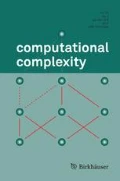Abstract
Maximal word functions occur in data retrieval applications and have connections with ranking problems, which in turn were first investigated in relation to data compression [21]. By the “maximal word function” of a languageL ⫅ ∑*, we mean the problem of finding, on inputx, the lexicographically largest word belonging toL that is smaller than or equal tox.
In this paper we present a parallel algorithm for computing maximal word functions for languages recognized by one-way nondeterministic auxiliary pushdown automata (and hence for the class of context-free languages).
This paper is a continuation of a stream of research focusing on the problem of identifying properties others than membership which are easily computable for certain classes of languages. For a survey, see [24].
Similar content being viewed by others
References
A. V. Aho and J. D. Ullman,The Theory of Parsing, Translation and Compiling, Volume I: Parsing. Prentice-Hall, 1972.
E. Allender,Invertible functions. Ph.D thesis, Georgia Institute of Technology, 1985.
E. Allender, P-Uniform Circuit Complexity.J. Assoc. Comput. Mach. 36 (1989), 912–928.
E. Allender andV. Gore, Rudimentary reductions revisited.Information Processing Letters 40 (1991), 89–95.
E. Allender and J. Jiao, Depth reduction for noncommutative arithmetic circuits.Proc. Twenty-fifth Ann. ACM Symp. Theor. Comput., 515–522, 1993.
E. Allender andR. Rubinstein, P-printable sets.SIAM J. Comput. 17 (1988), 1193–1202.
C. Álvarez andB. Jenner,A note on log space optimization. Report, L.S.I., Universitat Politècnica Catalunya, Barcelona, 1992.
C. Álvarez andB. Jenner, A very hard log-space counting class.Theoret. Comput. Sci. 107 (1993), 3–30.
J. Balcázar, J. Díaz andJ. Gabarró,Structural Complexity I. Springer Verlag, New York, 1987.
D. A. Mix Barrington, N. Immerman, andH. Straubing, On uniformity withinNC 1.J. Comput. System Sci. 41 (1990), 274–306.
A. Bertoni, D. Bruschi, andM. Goldwurm, Ranking and formal power series.Theoret. Comput. Sci. 79 (1991), 25–35.
A. Bertoni, M. Goldwurm, andN. Sabadini, The complexity of computing the number of strings of given length in context free languages.Theoret. Comput. Sci. 86 (1991), 325–342.
A. Borodin, S. Cook, P. Dymond, W. Ruzzo, andM. Tompa, Two applications of inductive counting for complementation problems.SIAM J. Comput. 18 (1989), 559–578.
F.-J. Brandenberg, On one-way auxiliary pushdown automata.Proc. 3rd GI Conference, Lecture Notes in Computer Science48 (1977), 133–144.
G. Buntrock andK. Loryś, On Growing Context-Sensitive Languages.Proc. 19th Int. Coll. Automata, Languages, and Programming, Lecture Notes in Computer Science623 (1992), 77–88.
S. Buss, S. Cook, A. Gupta, andV. Ramachandran, An optimal parallel algorithm for formula evaluation.SIAM J. Comput. 21 (1992), 755–780.
A. Chandra, L. Stockmeyer, andU. Vishkin, Constant Depth Reducibility.SIAM J. Comput. 13 (1984), 423–439.
S. Cook, Characterization of pushdown machines in terms of time-bounded computers.J. Assoc. Comput. Mach. 18 (1971), 4–18.
S. Cook, A Taxonomy of Problems which have a Fast Parallel Algorithm.Inf. and Comp. 64 (1985), 2–22.
M. Furst, J. Saxe, andM. Sipser, Parity, circuits, and the polynomial-time hierarchy.Mathematical Systems Theory 17 (1984), 13–27.
A. Goldberg andM. Sipser, Compression and ranking.SIAM J. Comput 20 (1991), 524–536.
L. Goldschlager, ε-productions in context-free grammars.Acta Informatica 16 (1981), 303–318.
L. Hemachandra andS. Rudich, On the complexity of ranking.J. Comput. System Sci. 41 (1990), 251–271.
L. Hemachandra, Algorithms from complexity theory: polynomial-time operations for complex sets.Proc. SIGAL Conference, Lecture Notes in Computer Science450 (1991), 221–231.
H. Hoover, M. Klawe, andN. Pippenger, Bounding fan-out in logical networks.J. Assoc. Comput. Mach. 31 (1984), 13–18.
J. Hopcroft and J. Ullman,Introduction to automata theory, languages and computations. Addison-Wesley, 1979.
D. Huynh, The complexity of ranking simple languages.Math. Systems Theory 23 (1990), 1–20.
D. Huynh, Efficient detectors and constructors for simple languages.Internat. J. Found. Comput. Sci. 2 (1991), 183–205.
M. Jerrum, G. Valiant, andV. Vazirani, Random generation of combinatorial structures from a uniform distribution.Theoret. Comput. Sci. 43 (1986), 169–188.
R. Karp and V. Ramachandran, A survey of parallel algorithms for shared-memory machines. InHandbook of Theoretical Computer Science, vol. I, North Holland, 1990.
M. Krentel, The complexity of optimization problems.J. Comput. System Sci. 36 (1988), 490–509.
C. Lautemann, One pushdown and a small tape. InDirk Siefkes, zum 50. Geburtstag (proceedings of a meeting honoring Dirk Siefkes on his fiftieth birthday), K. Wagner, ed., Technische Universität Berlin and Universität Augsburg, 1988, 42–47.
G. L. Miller, V. Ramachandran, andE. Kaltofen, Efficient Parallel Evaluation of Straight-Line Code and Arithmetic Circuits.SIAM J. Comput. 17 (1988), 687–695.
W. Ruzzo, On uniform circuit complexity.J. Comput. System Sci. 21 (1981), 365–383.
L. Sanchis andM. Fulk, On the efficient generation of languages instances.SIAM J. Comput. 19(2) (1990), 281–295.
L. Valiant, The complexity of enumeration and reliability problems.SIAM J. Comput. 8 (1979), 410–412.
H. Venkateswaran, Properties that characterize LOGCFL.J. Comput. System Sci. 42 (1991), 380–404.
H. Venkateswaran, Two dynamic programming algorithms for which interpreted pebbling helps.Inf. and Comp. 92 (1991), 237–252.




